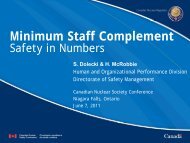Investigation of the Environmental Fate of Tritium in the Atmosphere
Investigation of the Environmental Fate of Tritium in the Atmosphere
Investigation of the Environmental Fate of Tritium in the Atmosphere
You also want an ePaper? Increase the reach of your titles
YUMPU automatically turns print PDFs into web optimized ePapers that Google loves.
INVESTIGATION OF THE ENVIRONMENTAL FATE OF TRITIUM IN THE ATMOSPHERE<br />
programs for tritium concentrations <strong>in</strong> air (Hart, 2008). In <strong>the</strong> absence <strong>of</strong> local data, default<br />
regional values are given <strong>in</strong> Table 3.4 for different seasons <strong>of</strong> <strong>the</strong> year. The values vary<br />
significantly with averag<strong>in</strong>g time and must be chosen to match <strong>the</strong> way <strong>in</strong> which Ha appears<br />
<strong>in</strong> a model. For example, an average over <strong>the</strong> snow-free period is appropriate for calculat<strong>in</strong>g<br />
<strong>the</strong> conversion <strong>of</strong> HT <strong>in</strong> air to HTO <strong>in</strong> air (Equation 1.8). Shorter averag<strong>in</strong>g times are more<br />
appropriate for Ha used <strong>in</strong> model<strong>in</strong>g conversion <strong>of</strong> HT <strong>in</strong> air to HTO <strong>in</strong> plants.<br />
The factor, foxid, is <strong>the</strong> fraction <strong>of</strong> <strong>the</strong> year when <strong>the</strong> soil is not frozen or snow covered, and<br />
is applied to allow for <strong>the</strong> decrease <strong>in</strong> HT oxidation and HTO re-emission rates <strong>in</strong> <strong>the</strong> w<strong>in</strong>ter.<br />
Site-specific data for this parameter should be used if available. For Ontario <strong>in</strong> <strong>the</strong> Chalk<br />
River/Pembroke area and for Quebec near Gentilly-2 (G-2), <strong>the</strong> recommended value for foxid<br />
is 0.67, based on <strong>the</strong> frost-free period reported <strong>in</strong> <strong>the</strong> Environment Canada Climate normal<br />
database for nearby climate stations. For sites <strong>in</strong> sou<strong>the</strong>rn Ontario (e.g., near Bruce Power<br />
(BP), <strong>the</strong> Picker<strong>in</strong>g Nuclear Generat<strong>in</strong>g Station (PNGS) and <strong>the</strong> Darl<strong>in</strong>gton NGS (DNGS))<br />
and for Po<strong>in</strong>t Lepreau, foxid should be assigned a value <strong>of</strong> 0.75.<br />
Table 3.4: Absolute Humidity, H a (L • m -3 ) Averaged over Various Seasons <strong>of</strong> <strong>the</strong><br />
Year at Stations Close to Canadian CANDU Facilities (from Hart, 2008).<br />
Site Annual<br />
Average<br />
Average Over <strong>the</strong><br />
Snow-free Period<br />
Average Over <strong>the</strong><br />
Grow<strong>in</strong>g Season<br />
Toronto Island (Picker<strong>in</strong>g) 0.0069 0.0089 0.012<br />
Trenton (Darl<strong>in</strong>gton) 0.0069 0.0089 0.012<br />
Wiarton (Bruce) 0.0066 0.0085 0.011<br />
Ottawa (CRL) 0.0050 0.0080 0.010<br />
Quebec City (Gentilly-2) 0.0047 0.0076 0.010<br />
Sa<strong>in</strong>t John (Po<strong>in</strong>t Lepreau) 0.0054 0.0075 0.010<br />
3.2.2 Soil Oxidation <strong>of</strong> Tritiated CH4<br />
The methane content (CH4) <strong>of</strong> <strong>the</strong> atmosphere is ra<strong>the</strong>r high, compared to o<strong>the</strong>r trace gases.<br />
The CH4 is strongly coupled with <strong>the</strong> H2 and CO cycles, contribut<strong>in</strong>g approximately 1% to<br />
<strong>the</strong> total atmospheric carbon cycle, as estimated by Ehhalt (1974).<br />
Oxidation <strong>of</strong> CH4 leads to <strong>the</strong> formation <strong>of</strong> carbon dioxide (CO2) and water. The large<br />
majority <strong>of</strong> <strong>the</strong> methane oxidation takes place <strong>in</strong> <strong>the</strong> upper atmosphere by photochemical<br />
reactions with OH (Burger, 1979; Freyer, 1977; Hart, 2008), with some methane oxidation by<br />
methanotrophic microorganisms <strong>in</strong> soils under aerobic conditions (Manc<strong>in</strong>elli, 1995), as<br />
described by <strong>the</strong> follow<strong>in</strong>g equation:<br />
CH 4 + 2 O 2<br />
CO + 2 H O<br />
2 2 Equation 3.5<br />
BACK TO TABLE OF CONTENTS 32



